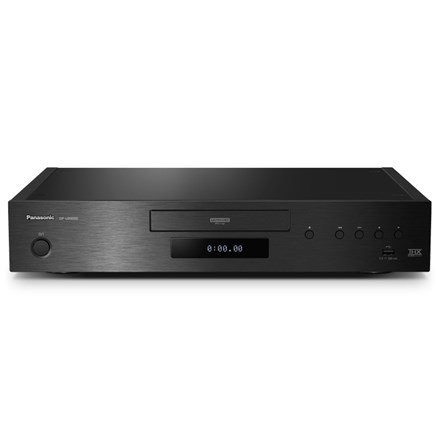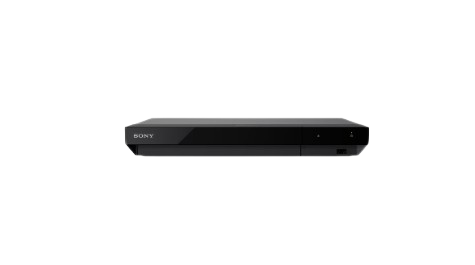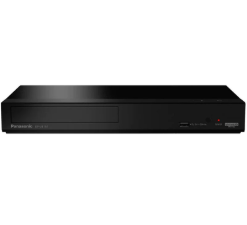When viewing movies and TV shows at home, the top 4K Blu-ray players provide the greatest possible visual quality. Despite the popularity of streaming services, Blu-rays provide better quality and realism by delivering video at a higher bitrate. Other advantages of Blu-rays include the fact that you can really own your collection of movies, as well as the beautiful box art and behind-the-scenes extras that are included on the disk.
It’s no surprise home theater lovers say one of the best 4K Ultra HD Blu-ray players is essential – however, with the rise of streaming services, dedicated disc players are less common
We’ve also got a section where we look at some of the best 4K Blu-ray discs that are recently released, and how they can show what the below players are capable of, especially when paired with a great TV and soundbar.
Table of Contents
- No 1 Panasonic DP-UB9000P1K
- No 2 Sony UBP-X700M
- No 3 Panasonic DP-UB154P-K
Top 3 Best 4K Blu-Ray Players In 2025
No 1 Panasonic DP-UB9000P1K

The Panasonic DP-UB9000 is the company’s latest flagship 4K Ultra HD Blu-ray player and, after Oppo started winding down its competing devices, the new model finds itself in a fortuitous position. The absence of Oppo has created a gap at the high-end player market, one that the Panasonic is perfectly suited to fill.
Not only is the player more than capable with images, it has audiophile aspirations as well, sporting high quality DACs, two-channel and 7.1-channel analogue outputs, and Hi-Res Audio support. Toss in a host of smart features, and the UB9000 ticks nearly every box in the book. Naturally all these flagship features don’t come cheap – but, for those seeking the ideal replacement Blu-ray player after Oppo’s collapse, the Panasonic DP-UB9000 is a more than adequate replacement.
The UB9000 tips the scales at 7.8kg, evidence of its tank-like construction. The double layer top plate and aluminium side plate are separately bolted, while the base of the chassis, also dual layer, consists of 1.2 and 1.6mm steel sheets. Attention to detail is high: The front fascia boasts a subtle hairline finish, and sports a front facing USB, plus transport and power controls.
Disc loading times are relatively fast, too. The deck takes a heavily authored Goldfinger Blu-ray from tray to main menu in 40 seconds. The disc loading mechanism, affixed to a 1.2mm steel plate, is buttery smooth.
Pros
- Sensational image quality
- Four types of HDR support
- Powerful HDR display optimizer
Cons
- No SACD or DVD-Audio playback
- CD playback is acerbic
No 2 Sony UBP-X700M

The Sony UBP-X700 is an effective 4K Blu-ray player that’s packed with a good number of features for an affordable price. The UBP-X700’s interface is easy enough to navigate, although a little on the plain side.
A good number of settings for video and audio are provided. Design-wise, the UBP-X700 is compact, making it ideal for smaller spaces, though its physical design is plain – an LED display with playback info would have been welcome – and its remote feels very dated.
The UBP-X700 supports the Dolby Vision and HDR10 high dynamic range formats, but not HDR10+. For comparison, the cheaper Panasonic DP-UB150 supports HDR10+, but not Dolby Vision, while the pricier Panasonic DP-UB820 supports both Dolby Vision and HDR10+. One frustration I had involved the player’s Dolby Vision menu setting.
With Dolby Vision turned on, the UBP-X700 indicated it was displaying Dolby Vision movies even when it wasn’t – even leaving it on when watching regular Blu-ray discs without HDR. I could see no obvious related picture issues, but it was still frustrating having to turn this on and off as there are some SDR-specific picture settings to improve quality which are locked when Dolby Vision HDR is activated.
Pros
- Excellent Dolby Vision presentation
- Built-in Wi-Fi for streaming
- Good value
Cons
- Annoying Dolby Vision setting
- No HDR10+ support
- Somewhat dated menus
No 3 Panasonic DP-UB154P-K

The DP-UB154 is a 4K Blu-ray player that offers multiple playback options, including 4K and regular Blu-ray, DVD, CD and even hi-res audio for a cheap price. It supports HDR10+ video and the Dolby Atmos and DTS:X audio formats, but there is no Dolby Vision or Wi-Fi for streaming. Stock and availability does vary from region to region, however.
For those who can’t get hold of the DP-UB154, the Panasonic DP-UB150 is almost identical in terms of specs and features so this is a good alternative if you’re struggling to get hold of the UB154. In terms of picture quality, 4K HDR images look fantastic through the UB154, with excellent detail and contrast. Upscaling is effective across the board for HD Blu-ray and DVD, although DVD can still look fuzzy at times.
This player is all about doing its main job of displaying discs at an excellent standard, while making sacrifices to features and design. However, if you are after just a simple 4K Blu-ray player, you can’t really go wrong as this is one of the best budget players around.
Pros
- Excellent picture quality
- Budget-friendly price
- Upscaling is effective
Cons
- Bland design
- Can be sluggish at times
- No Dolby Vision support
Do you need a special Blu-ray player for 4K?
Firstly, let’s cut through some confusion. There is the Blu-ray format and then there is the newer 4K Ultra HD Blu-ray format – these are two different things.
What this means is that if you have a Blu-ray disc you can play that on both a Blu-ray player and an 4K Ultra HD Blu-ray player. If you have an 4K Ultra HD Blu-ray disc, you can only play that on a 4K Blu-ray player.
You might find that when you buy a Blu-ray disc it also comes with a regular DVD version to use with older players. Similarly, if you buy a 4K Ultra HD Blu-ray disc it may also come with a Blu-ray version too. However, this isn’t always standard so make sure you check you have the right one before you buy.
Do older movies look good in 4K?
The short answer is yes, but the slightly longer answer is: it depends on the film, and on the quality of the digital copy.
If the disc you’re playing isn’t 4K, your blu-ray player will upscale it. That uses an algorithm to fill in the gaps between the quality of the source material and what a 4K version would be, and the best 4K players do a superb job of this. They can’t work miracles but we think you’ll be pleasantly surprised by how much better your older discs can look when they’ve been upscaled.
The holy grail for fans of older movies is the digital restoration. That’s when a classic or cult movie is digitised with plenty of care and consideration, with the goal of delivering it as the filmmakers intended. With films shot on 35, 65 or 70mm film stock, which most big-budget productions were, that film stock was equivalent to a much higher resolution than Blu-Ray (even 4K) – so scanning each frame with modern tech for a 4K Blu-Ray release can deliver absolutely spectacular results.
We say “can deliver” rather than “does deliver” because there are lots of variables in play here, ranging from how carefully the original film stock has been stored to the skills of the restorers and the resources they’ve been given. That’s particularly apparent with remastered films released in the early days of Blu-Ray, not all of which were as good as they could have been. However, more careful restorations, such as the 11-month, 2,700-hour restoration of Apocalypse Now for its 40th anniversary edition, or the 4K Blu-ray of Casino, are absolutely stunning and make you feel like you’re watching the film for the very first time.
What TV do I need to use a 4K UHD Blu-ray player?
It may seem obvious, but it’s worth clarifying that you’ll need to own one of the best 4K TVs to warrant buying a 4K Ultra HD Blu-ray player. A 4K player will still work if you’re using a HD TV, mind, but picture quality will be limited to 1080p.
That said, HD Blu-ray discs will be upscaled to 3840 × 2160 (4K) resolution by way of filling in the extra pixels, but the quality will appear noticeably lower-grade than Ultra HD Blu-ray discs (which provides a native 4K image).
How do 4K Blu-Rays compare to streaming quality?
They’re much superior. The bandwidth speeds at which 4K video is sent range from 20Mbps to 40Mbps, depending on the streaming provider. Up to 128Mbps is far more than 4K Blu-Ray offers. Additionally, it dependably delivers that data since there is no network congestion to cause your stream to lag or buffer as you approach the greatest parts.
That’s important since streaming requires tradeoffs due to its reduced bandwidth. For instance, streaming video using Dolby Atmos often arrives in the compressed Dolby Digital+ format. Dolby TrueHD in full resolution is available on Blu-ray. It must be on a disc if you want DTS:X, which offers more control and detail than Atmos.
The selling point of streaming is convenience and low cost (although some services charge more for higher quality streaming), and it definitely delivers instant gratification. But when it comes to the ultimate AV experience, Blu-Ray can’t be beaten.
What is a good brand of Blu-ray player?
For most people, the slam dunk brand is Panasonic, who offer extremely well-made units across a range of prices, all of which deliver great video quality.
Another popular brand is Sony, which will often not as feature packed as Panasonic’s main players do offer a high quality alternative with great picture and a good number of features.
We wouldn’t suggest buying a 4K Blu-ray player any cheaper than the lowest-priced options from Sony or Panasonic, such as the Sony UBP-X700 or Panasonic DP-UB150/154.
At the high-end, Magnetar and Reavon are two big names – and both are essentially from the same company, so you can choose options from either brand based mostly on whatever elite connection options you want.
Please be aware that we may receive a commission if you buy something after clicking on the links in our stories. This helps to fund our work. Thank you for your support and attention. Feel free to look around further to find out more about how these commissions support our work. Top Great Reviews

